Pictured Above: Working with a diverse mix of customers and cropping practices in the southwest U.S., Layne Richins, precision ag manager at Stotz Equipment, strives to increase adoption of precision technology in the area.
One of the first things we tell willing participants who ask how to prepare for our visit is that they should just plan for a typical day. Of course, there is no such thing for precision farming specialists, but the reassuring words tend to relieve any pressure that something dramatic needs to be arranged.
No two days are ever the same, and riding along with Layne Richins, precision ag manager with Stotz Equipment for this installment of Day in the Cab, provided the most unique experience to date.
The John Deere dealership group operates 25 stores throughout Arizona, California, Colorado, Nevada, New Mexico, Utah and Wyoming. Layne started as a mechanic 14 years ago and gradually added more precision farming service responsibilities as the dealership developed this side of the business.
But rather than maintain a separate Integrated Solutions department, Stotz chose to run its precision business through the service department. Since 2013, Layne has divided his responsibilities between being service manager at the dealership’s Casa Grande, Ariz., location and the precision farming coordinator for all of Stotz’s stores.
“Each one of our major ag locations has a precision tech who supports the technology, but they report to the service manager,” Layne says. “Precision revenue flows through the service department because it just made sense from a structural and financial standpoint, rather than create an new department that would have to support itself.”
The blueprint seems to suit the diversity of customers and cropping systems Layne works with on a daily basis. While he acknowledges that the area is lagging in adoption and advancement of precision technology, he has progressive customers willing to listen and learn about the latest innovations.
Whether training a seasonal operator on a sprayer setup, installing a land leveling design or pitching the benefits of a data management platform, Layne pivoted from task to task with exhaustive effort, efficiency and a relaxed nature.

Layne Richins started as a mechanic 14 years ago with Stotz Equipment, and that experience helped him transition into a dual role as the service manager at the Casa Grande store and the precision ag manager of the dealership’s 25 locations.
5:45 a.m. The alarm on my smart phone wakes me out of a dead sleep in my hotel room and I notice that it’s still dark outside. I gradually regain my senses and take inventory of what I’ll need for the day.
6:22 a.m. I grab a large mocha at the café in the lobby and hop in my rental car. The sun is slowly rising over the desert hills as I make the hour long drive from Scottsdale to Casa Grande, where I’ll rendezvous with Layne. He oversees a team of 16 field technicians at his home store, along with 10 precision farming specialists for the entire dealership network as the precision ag manager.
7:35 a.m. I arrive at the dealership, which is next to a post office and little else, aside from cacti and desert. Having never met Layne, I ask where I can find him and Wade Defreese, shop manager, directs me to the hallway toward the shop to find the “big, bald guy.” I easily spot and introduce myself to Layne. We proceed to touch base with several members of the parts and service team to see what they have planned for the day. It’s evident immediately that the staff has a casual camaraderie and Layne says they’ve had little turnover at the store in recent years. “You can say we have a loose crew, but not a loose screw,” he jokes.
Dealer Takeaways
A patient and thorough approach training operators on technology updates can reduce redundant follow-ups.
Incorporating real customer data when explaining ROI of data management platforms makes it more relevant and understandable.
Partnering with customers, rather then pushing products will create more opportunity to increase adoption of precision technology.
7:55 a.m. As Layne gathers what we’ll need for the day, he shows me a land forming design on a tablet that he developed to improve water flow and retention on a customer’s farm. “In Arizona, everything is irrigated and we don’t get much rain, so anything we can do to retain and better use the moisture we do have is critical,” Layne says. He had surveyed the customer’s field the day before to get the baseline slope and created the redesign in a program known as Terra Cutta, a precision land forming platform that can be created and exported into Deere’s GreenStar displays. The plan is to deliver and install the design to the customer today.
8:15 a.m. Layne fills the cooler in his flatbed with ice and adds a few cubes to his coffee to lower the temperature to a drinkable level. The dealership carries Yeti products and he says ice is a mandatory addition every morning to his thermos of coffee. His backup beverage of choice is diet Mountain Dew. We hop in the service truck and depart for our first stop at Brian Rhodes’ farm near Coolidge, Ariz., to activate the section control and AutoTrac systems on a new R4038 sprayer. Rhodes is one of the dealership’s larger customers and owns 21 pieces of equipment running on the JDLink platform.
8:32 a.m. We see the sprayer on the edge of a cotton field coming toward us and pull into an access area to meet the operator. Unlike many family owned and operated farms in the Midwest, Layne says it’s extremely rare to meet with an owner on a service call because the operations are often large and more spread out, so hired help is the standard practice. “Sometimes there can be a language barrier between me and operator, so that’s something to overcome,” Layne says. “That’s why it’s important to ride along with operators and train them so they can get comfortable with the technology.”
"Precision revenue flows through the service department because it makes sense from a structural and financial standpoint..."
8:44 a.m. Layne hops into the sprayer cab and after walking the operator through the system setup, goes for a test drive in the field. Rhodes wants to make another herbicide application on the cotton field ahead of harvest because a rain diminished the effectiveness of an earlier application and plants are getting too green. I move the service truck out of harms way as the sprayer heads into the field. A distinct odor fills the air once the application starts.
9:25 a.m. After several passes through the field, Layne is confident the operator is comfortable with the system. I trade spots with Layne and hop in the sprayer cab and make a few passes with the operator who has been spraying fields in the area for more than 25 years. He acknowledges that the system will take some getting used to, but he’s looking forward to a reduction in stress and application overlap.
10:01 a.m. We wrap up the visit and depart for our next destination, Rudy Belloc’s operation near Eloy, Ariz., about 15 miles away to deliver and upload the land leveling design Layne had worked on a day earlier.
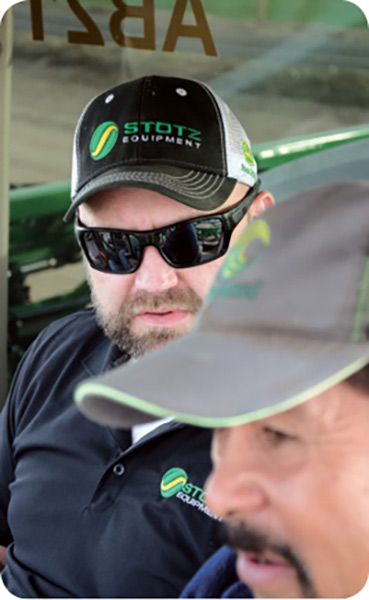
Meeting with an operator to setup section control on a new sprayer, Layne Richins says it’s extremely rare to meet with an owner on a service call because the operations are often large and more spread out. “That’s why it’s important to ride along with operators and train them so they can get comfortable with the technology,” he says.
10:17 a.m. On the ride, we talk about the video we shot at Rhodes’ farm and I note that Layne appeared very relaxed and comfortable on camera. He mentions that he’s had prior experience as a Home Shopping Network pitchman for Icon treadmills as part of an exercise promotion he took part in. While Hollywood is only about 7 hours away, Layne jokes that he had no intention of pursuing an acting career.
10:34 a.m. We arrive at Rudy’s farm and find him behind the wheel of a 7200R tractor pulling a Miskin land scraper. “He’s just doing it by eye right now,” Layne says of the handful of passes Rudy has made so far, moving dirt on a recently harvested and plowed cotton field. Layne grabs the tablet with the leveling design and we deliver it to Rudy who parks near a Starfire 3000 GPS receiver base station on the edge of the field.
10:55 a.m. After attaching the receiver to the top of the tractor, Layne and Rudy hop in the cab to upload the leveling design. They make several passes through the field, and leave small clouds of sandy dust in their wake, despite only traveling 3-5 mph.
11:14 a.m. Satisfied with the installation and upload of the design, Layne hops out of the cab and I jump in with Rudy to make a few passes. The 86 acre field will be divided in half, with a ditch pad created in the center so water will flow to either side more evenly. Rudy acknowledges that even with 2 tractors running the design and GPS, it will be a time-consuming and tedious job, taking nearly 6 weeks to level the entire field. But, the payoff will be well worth it. He had leveled another field last year and saved 1.5 acre-foot of water, which is substantial.
11:42 a.m. We wrap up with Rudy and jump back into the truck. I notice that the odometer has more than 63,000 miles on it and Layne says most of those have been put on during the last year. While he typically services a 50 mile radius around the Casa Grande store, being the Integrated Solutions Coordinator for all of Stotz Equipment’s 25 stores spread throughout 8 states, more extensive travel is occasionally required.
"Everyone around here knows that the sun will shine again tomorrow so customers aren’t running 24/7. It’s a different pace and atmosphere out here..."
12:12 p.m. Ahead of schedule for the day, we have time for a dine-in lunch at Buffalo Wild Wings in Casa Grande. Like most precision staff I’ve ridden along with in this series, Layne says his daily agenda dictates if and when he breaks for lunch. Today is somewhat of a luxury, as we share a cheese curd appetizer and I order a pulled pork sandwich with an iced tea. Layne gets chicken strips with honey BBQ sauce and a dry desert heat rub, which he mixes together, and an ice tea.
We discuss fantasy football and our sports allegiances. Layne moved to Arizona 3 years ago, but grew up in Idaho as a San Diego Chargers fan.
12:45 p.m. We arrive back at the dealership where we’ll be meeting Norman and Mark Hamilton, brothers and co-owners of Normark Farms, for an appointment to discuss a data management service package. Layne acknowledges that in general, the Southwest is behind the adoption curve for precision farming technology, which can pose challenges when trying to convince customers to continue updating or upgrading technology. However, the Hamiltons are among the more progressive farmers that Layne works with and he says they are anxious to take advantage of new technological advancements.
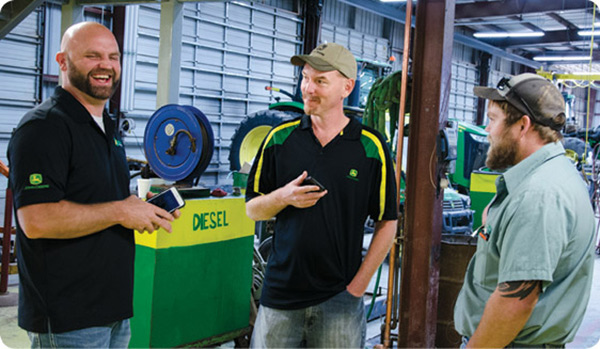
With very little turnover among the 16 field technicians that Layne Richins manages at the Casa Grande store, the team has a casual camaraderie. “You can say we have a loose crew, but not a loose screw,” he jokes.
1:10 p.m. Layne receives a call from the operator we visited earlier on Brian Rhodes’ farm with a problem. “He says the sprayer stopped spraying,” Layne says.
“I think it’s because he didn’t change the field on the monitor.” Layne tells him he’ll try and login into the display via Deere’s remote display access to diagnose the problem. He first locates the sprayer in the field via Deere’s operations center and then attempts to connect with the monitor. “This way, we’ll be able to see what he’s seeing on his screen,” Layne says.
1:21 p.m. A slow connection elicits a sigh from Layne, quickly followed by a service technician who pops in with a question about a repair on a 2001 cotton picker and how to prioritize it. Layne takes the momentary chaos in stride and dispatches the service tech, but receives a warning message regarding the remote support connection. “This is usually a great tool, unless something like this happens,” he says. He dials up Deere’s precision support hotline and is greeted with an automated message asking if he’d like to participate in a brief survey, which he laughs off.
"Sometimes there can be a language barrier between me and operator, so that’s something to overcome..."
1:32 p.m. Explaining the situation to the support person, Layne is informed that the remote support subscription is more than 2 years old and has expired. A new subscription is purchased and activated. “Probably what happened is we bought the sprayer from Deere and had it in our inventory for more than 2 years and never sold it,” Layne says. “So I purchased a new subscription and will make a work order and bill it out to the customer.” Layne tries again to connect with the sprayer, but still isn’t able to acquire a remote signal from the tractor. Rather than wait, he calls the operator back and has him restart the display and talks him through reconnecting to the receiver. Several button pushes later, Layne gets the operator to create a new field in the system and that ultimately solves the problem. “That’s what I figured, but it would have been nice to see that on his display.”
1:55 p.m. The Hamiltons arrive and we meet them in the conference room at the dealership. It’s a well-suited space for private customer conversation, more formal than an office setting, but also accommodating with a large screen television.
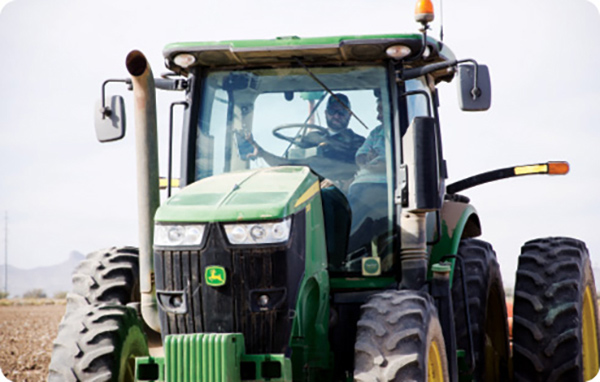
Designing and implementing field leveling programs is an emerging precision farming service for Layne Richins. Water is a precious commodity in Arizona and redesigning field slope can save 1.5 acre-foot of water annually.
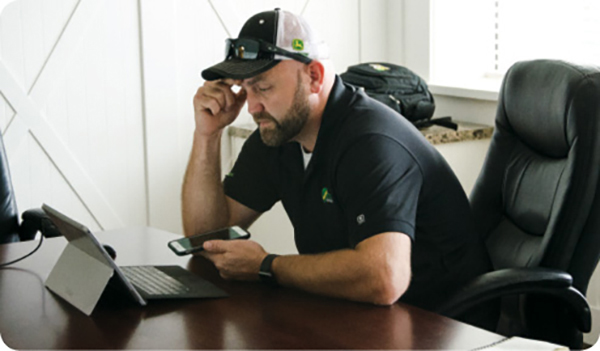
Utilizing remote support can be a time-saving asset for Layne Richins, but in some cases, a weak connection or expired subscription can cause temporary headaches. “This is usually a great tool, unless we run into an issue,” he says.
2:14 p.m. After a little small talk about the ongoing cotton harvest, Layne logs into his laptop to share some model analytics he developed based on the Hamiltons farm in the AgDNA program, a cloud-based application for collecting and reporting field information. He runs through several features using a mix of hypothetical and factual data from their operation to highlight value points including tracking annual harvest data by field, seeding rates and creating a cost-per-acre scorecard. Layne is detailed with the presentation, frequently calling attention to points where he incorporated the Hamiltons’ data to make it more personal and relevant.
3:08 p.m. As Layne wraps up after more than an hour-long discussion, Norman leaves for another appointment. Mark reiterates their interest in the platform, but plainly asks how the program can be applied to their farm. Layne explains that his goal is to equip them with the tools to make decisions, and that the best approach would be a collaborative effort, choosing features that are going to offer the most value to their operation. “I want to track these things, so you can see where you are with expenses, returns and yield,” Layne says. Mark says they’ll be in touch.
3:17 p.m. During our visit with the Hamiltons, I received a text from local farmer Robert Boyle, who I had visited the day before near Coolidge, Ariz. He purchased his 8 row Orthman 1tRIPr strip-till rig from Stotz and his message said he would be in the field if we had time to stop out today. Layne touches base with a few service technicians at the dealership and finding things in good shape, I text Robert back and let him know we’re en route.
3:45 p.m. Nearing the field where Robert should be, I get a follow-up text from him saying he called it quits for the day because of a GPS issue. While Robert works with Stotz for some farm equipment needs, he has a different dealer for precision farming products, using primarily Trimble technology on his operation, so we head back to the store.
4:21 p.m. We arrive and it’s noticeably quiet at the dealership. Layne notes that it’s typical for farmers in this part of the country to conclude daily field operations far earlier than those in other areas. “Everyone around here knows that the sun will shine again tomorrow,” he says. “Customers aren’t running 24/7. It’s a different pace and atmosphere than what you see in other parts of the country.”
4:45 p.m. Having been away from his office the entire day, Layne finds a couple of packages on his desk and a bit of paperwork to review prior to heading home. I thank Layne for an educational and unique Day in the Cab experience.
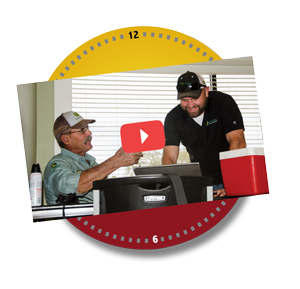
Check Out Day In the Cab Videos!
Take a closer look at a day in the life on the job with Layne Richins, precision ag manager with Stotz Equipment, through exclusive videos filmed during Precision Farming Dealer’s Day in the Cab.
Visit www.PrecisionFarmingDealer.com/ditc.

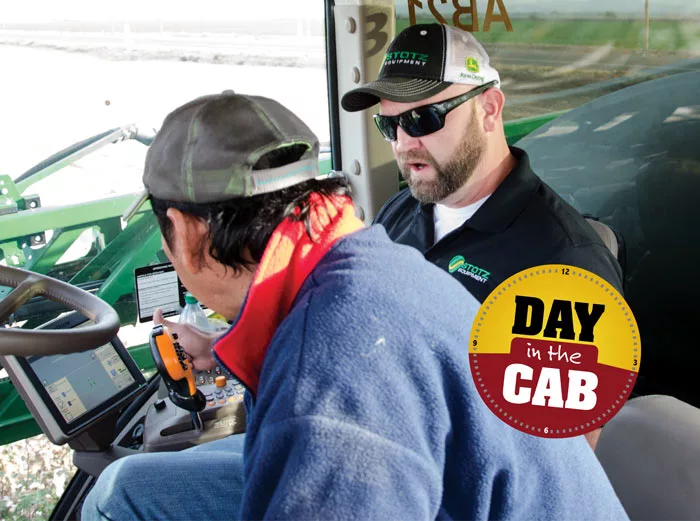


![[Technology Corner] Autonomy & Robotics Take Center Stage](https://www.precisionfarmingdealer.com/ext/resources/2026/01/12/Autonomy--Robotics-Take-Center-Stage.webp?height=290&t=1768253759&width=400)


